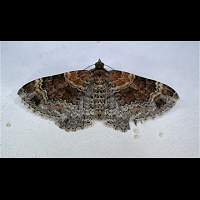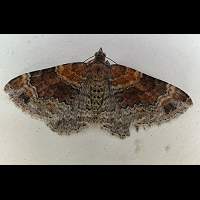Red Twin-spot Carpet or Dark-barred Twin-spot Carpet (Xanthorhoe ferrugata or Xanthorhoe spadicearia)
The names of these two species may seem to suggest they may be told apart easily. This suggestion however is wrong. In a very few situations you can tell them apart, but many other characteristics suggested by books over the years have all proved to be in error. The only secure way of telling apart the Red Twin-spot Carpet and the Dark-barred Twin-spot Carpet is by dissection. Just like most visitors to this site we don't do that. So we have to settle for never knowing for sure. Both species together however are easily identified by the double dot. Reaching a wing span of some 24 to 27mm, both are the same size.
The caterpillars of these two moths are hard to tell apart too. Usually those of the Dark-barred Twin-spot Carpet are darker and show more contrast. Both live on a great number of low plants, overwinter as pupa and are extremely hard to find in the wild. The larvae reach a length of some 20 to 25 mm.
To add to all confusion both species fly at the same time of the year. In Southern England they are double brooded and on the wing from mid-May to mid-June and again in late July and throughout August. In the rest of Britain there is one generation only, on the wing from late May to mid-July. Both fly by night only, but are easily disturbed during the day. Often seen resting during the day on walls, trees and fences. Both species prefer light, sandy soils and are regular visitors to gardens and parks. They are easily photographed, but refuse to be handled. The Red Twin-spot Carpet is common throughout the British Isles, including Orkney and the Inner Hebrides. The Dark-barred Twin-spot Carpet though is common in England, Wales and Ireland, but much scarcer and usually a local species only in Scotland, including the Inner Hebrides.
The names of these two species may seem to suggest they may be told apart easily. This suggestion however is wrong. In a very few situations you can tell them apart, but many other characteristics suggested by books over the years have all proved to be in error. The only secure way of telling apart the Red Twin-spot Carpet and the Dark-barred Twin-spot Carpet is by dissection. Just like most visitors to this site we don't do that. So we have to settle for never knowing for sure. Both species together however are easily identified by the double dot. Reaching a wing span of some 24 to 27mm, both are the same size.
The caterpillars of these two moths are hard to tell apart too. Usually those of the Dark-barred Twin-spot Carpet are darker and show more contrast. Both live on a great number of low plants, overwinter as pupa and are extremely hard to find in the wild. The larvae reach a length of some 20 to 25 mm.
To add to all confusion both species fly at the same time of the year. In Southern England they are double brooded and on the wing from mid-May to mid-June and again in late July and throughout August. In the rest of Britain there is one generation only, on the wing from late May to mid-July. Both fly by night only, but are easily disturbed during the day. Often seen resting during the day on walls, trees and fences. Both species prefer light, sandy soils and are regular visitors to gardens and parks. They are easily photographed, but refuse to be handled. The Red Twin-spot Carpet is common throughout the British Isles, including Orkney and the Inner Hebrides. The Dark-barred Twin-spot Carpet though is common in England, Wales and Ireland, but much scarcer and usually a local species only in Scotland, including the Inner Hebrides.





